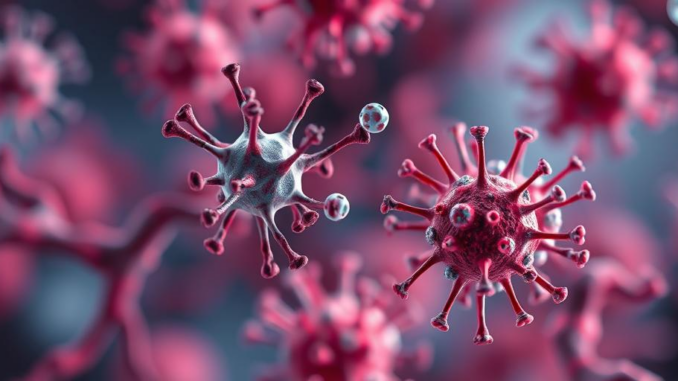
Summary
This article explores the emerging research on molecular mimicry as a potential driver of autoimmune diseases following COVID-19 infection. Scientists are using advanced data analysis and machine learning to identify viral “mimics” that resemble human proteins, potentially triggering the immune system to attack healthy tissues. This research could lead to new diagnostic tools and targeted therapies for COVID-induced autoimmune disorders.
Healthcare data growth can be overwhelming scale effortlessly with TrueNAS by Esdebe.
** Main Story**
Okay, so we’re seeing this uptick in autoimmune diseases post-COVID, right? And it’s not just a coincidence. One of the leading ideas floating around is molecular mimicry. Basically, the virus has proteins that look remarkably similar to our own. Think of it as the virus wearing a disguise that’s a little too convincing.
Because of this close resemblance, our immune system gets confused; it starts attacking healthy tissues because it thinks they’re the virus. Talk about friendly fire! And that, in a nutshell, can trigger all sorts of autoimmune problems. It’s a real mess, frankly. Autoimmune diseases can affect pretty much any part of the body.
Hunting the Imposters: Data and AI to the Rescue
Fortunately, we’re not totally in the dark. With some cool advances in data analysis and machine learning, scientists are getting much better at spotting these molecular mimics. What they do is they sift through the virus’s genetic code, the SARS-CoV-2 genome, and compare it to our own proteins – specifically the ones we know are linked to autoimmune conditions.
And that’s where the machine learning comes in. These models basically fine-tune the search and pinpoint which viral bits are most likely to bind to human antibodies and set off an autoimmune response. It is like using a magnifying glass on a detailed map; very precise.
The Genetic Card: Are Some People More at Risk?
Now, here’s where it gets even more interesting and complex. Research is showing that genetics might play a role in all of this. So, some of those human proteins targeted by these viral mimics? Turns out, they only show up in people with certain genetic makeups. Basically, if you’ve got a specific genetic profile, you might be more likely to develop an autoimmune disease after getting COVID-19. I mean, talk about bad luck, right?
Diabetes: A Specific Worry
Take Type 1 diabetes, for example. That’s an autoimmune disease where the immune system attacks and destroys the insulin-producing cells in the pancreas. And, yes, researchers are looking into how molecular mimicry could be a trigger after a COVID infection. It’s a complicated puzzle, but they’re working on it.
Silver Linings: Diabetes Management is Evolving
So, while the potential link between COVID and autoimmunity is definitely concerning, there’s good news too. We’re making serious strides in managing diabetes. And it is not just for Diabetes, the research is promising for other areas as well. Here are a few of the highlights:
- GLP-1 Receptor Agonists: These drugs are showing real promise in managing both Type 1 and Type 2 diabetes. They help stimulate insulin production and keep blood sugar levels in check.
- Artificial Pancreas Systems: These are pretty slick! They constantly monitor your blood sugar and automatically adjust insulin delivery. It’s way better than having to do it manually all the time.
- Stem Cell Therapy: This is more of a long-term, potential game-changer. Researchers are trying to use stem cells to grow new insulin-producing cells, which could restore pancreatic function. Imagine that!
- AI-Powered Insulin Delivery: And get this – there are clinical trials happening right now using AI to automate insulin dosing. It could seriously refine how artificial pancreas systems work. What will they think of next?
The Big Picture: Future Research and Treatment
All this research into molecular mimicry has huge implications for how we understand and treat autoimmune diseases. As we learn more about these viral doppelgangers and how they mess with our immune systems, we can create better ways to diagnose at-risk people, and we can design really targeted treatments to stop or lessen the autoimmune reactions. It’s all about improving life for people dealing with these conditions in this post-COVID world.
Beyond COVID: A Broader Perspective
While COVID is the current focus, molecular mimicry isn’t unique to this virus. Scientists think similar things might be happening in other autoimmune diseases triggered by different infections. Think multiple sclerosis or Guillain-Barré syndrome, for example. This makes it clear we need to keep digging into molecular mimicry. It’s a crucial piece of the autoimmune puzzle, don’t you think?
Personalized Medicine: A Glimmer of Hope
Finally, because we now know there are genetic predispositions to COVID-induced autoimmunity, this opens the door for more personalized medicine. By understanding someone’s unique genetic profile, doctors can get a better sense of their risk for developing specific autoimmune disorders after getting sick.
With this knowledge, doctors can then monitor things more closely and intervene early, which could prevent or lessen the severity of autoimmune reactions. As research keeps moving forward, personalized medicine will likely play a much bigger role in how we diagnose, treat, and prevent autoimmune diseases. I feel that that is a very exciting prospect and, in my opinion, should be looked at closer by researchers.


The use of machine learning to identify viral mimics is fascinating. Could this technology be adapted to predict autoimmune responses to other environmental triggers beyond viral infections?